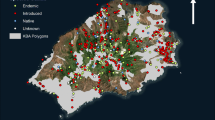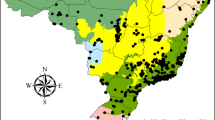Abstract
Using information from two recently published atlases of threatened invertebrate species in peninsular Spain, we examined the climatic, land use and geographic characteristics of the 100 km2 UTM cells with most likelihood of suffering extinctions (extinction cells), as well as the attributes of the species prone to population extinctions. Extinction cells have had significantly (1) lower precipitation values, (2) higher temperatures, (3) higher percentages of anthropic land uses or (4) higher rates of anthropization during the last 20 years than the remaining cells. Nevertheless, probable extinctions may occur under a wide range of climatic and anthropization change rates and these variables can only explain a low proportion (~5 %) of variability in the occurrence or number of extinction cells. Aquatic species seem to suffer higher local extinction rates than terrestrial species. Interestingly, many invertebrate species with approximately 25 or less occurrence cells are on a clear trajectory towards extinction. These results outline the difficulties and uncertainties in relating probable population extinctions with climatic and land use changes in the case of invertebrate data. However, they also suggest that a third of the considered Spanish threatened species could have lost some of their populations, and that current conservation efforts are insufficient to reverse this tendency.



Similar content being viewed by others
References
Abellán P, Sánchez-Fernández D, Velasco J, Millán A (2007) Effectiveness of protected area networks in representing freshwater biodiversity: the case of a Mediterranean river basin (south-eastern Spain). Aquat Conserv 17:361–374
Araújo MB, Lobo JM, Moreno JC (2007) The effectiveness of Iberian protected areas in conserving terrestrial biodiversity. Conserv Biol 21:1423–1432
Berglund H, Jonsson BG (2005) Verifying an extinction debt among lichens and fungi in Northern Swedish Boreal Forests. Conserv Biol 19:338–348
Bräutigam A, Jenkins M (eds) (2001) The red book: the extinction crisis face to face. IUCN and CEMEX S.A, México
Brooks TM, Mittermeier RA, Mittermeier CG, Da Fonseca GAB, Rylands AB, Konstant WR, Flick P, Pilgrim J, Oldfield S, Magin G, Hilton-Taylor C (2002) Habitat loss and extinction in the hotspots of biodiversity. Conserv Biol 16:909–923
Cardoso P, Arnedo MA, Triantis KA, Borges PAV (2010) Drivers of diversity in Macaronesian spiders and the role of species extinctions. J Biogeogr 37:1034–1046
Cardoso P, Borges PAV, Triantis KA, Ferrández MA, Martín JL (2011) Adapting the IUCN Red List criteria for invertebrates. Biol Conserv 144:2432–2440
Cardoso P, Borges PAV, Triantis KA, Ferrández MA, Martín JL (2012) The underrepresentation and misrepresentation of invertebrates in the IUCN Red List. Biol Conserv. doi:10.1016/j.biocon.2012.02.011
Carpaneto GM, Mazziotta A, Valerio L (2007) Inferring species decline from collection records: roller dung beetles in Italy (Coleoptera, Scarabaeidae). Divers Distrib 13:903–919
Clark-Labs (2000) Global change data archive. 1 km global elevation model. CD-Rom, Clark University
Cox PA, Elmqvist T (2000) Pollinator extinction in the pacific islands. Conserv Biol 15:1237–1239
Daily GC, Ehrlich PR (1995) Preservation of biodiversity in small rainforest patches: rapid evaluations using butterfly trapping. Biodivers Conserv 4:35–55
Daily GC, Ehrlich PR, Sánchez-Azofeifa GA (2001) Countryside biogeography: use of human-dominated habitat by the avifauna of southern Costa Rica. Ecol Appl 11:1–13
Darwall WRT, Vié JC (2005) Identifying important sites for conservation of freshwater biodiversity: extending the species-based approach. Fisheries Manag Ecol 12:287–293
Desender K, Turin H (1989) Loss of habitats and changes in the composition of the ground and tiger beetle fauna in four West European countries since 1950 (Coleoptera: Carabidae, cicindelidae). Biol Conserv 48:277–294
Didham RK, Tylianakis JM, Gemmell NJ, Rand TA, Ewers RM (2007) Interactive effects of habitat modification and species invasion on native species decline. Trends Ecol Evol 22:489–496
Diniz-Filho JAF, De Marco Jr P, Hawkins BA (2010) Defying the curse of ignorance: perspectives in insect macroecology and conservation biogeography. Insect Conserv Diver 3:172–179
Dunn RR (2005) Modern insect extinctions, the neglected majority. Conserv Biol 19:1030–1036
Europarc (2008) Mapa de áreas protegidas de España. Observatorio Europarc-España, Madrid. Available at: www.europarc-conservacion.es/
Evans HE (1993) Life on a little-known planet: a biologist’s view of insects and their world. Lyons and Burford, New York
Gaston KJ, Mound LA (1993) Taxonomy, hypothesis testing and the biodiversity crisis. Proc R Soc Lond B 251:139–142
Goodman D (1987) The demography of chance extinction. In: Soulé ME (ed) Viable populations for conservation. Cambridge University Press, New York, pp 11–34
González-Oreja JA (2008) The encyclopedia of life vs. the brochure of life: exploring the relationships between the extinction of species and the inventory of life on Earth. Zootaxa 1965:61–68
Herbert ME, McIntyre PB, Doran PJ, Allan JD, Abel R (2010) Terrestrial reserve networks do not adequately represent aquatic ecosystems. Conserv Biol 24:1002–1011
Hernández-Manrique OL, Numa C, Verdú JR, Galante E, Lobo JM (2012) Current protected sites do not allow the representation of endangered invertebrates: the Spanish case. Insect Conserv Divers. doi:10.1111/j.1752-4598.2011.00175.x
Hijmans RJ, Cameron S, Parra JL, Jones P, Jarvis A (2005) Very high resolution interpolated climate surfaces for global land areas. Int J Climatol 25:1965–1978
IUCN (2010) Numbers of threatened species by major groups of organisms (1996–2009). IUCN Red List version 2010. 3rd edn.
Jones GP, McCormick MI, Srinivasan M, Eagle JV (2004) Coral decline threatens fish biodiversity in marine reserves. P Natl Acad Sci USA 101:8251–8253
Kendall RJ, Lacher TE, Cobb GP, Cox SD (2010) Wildlife toxicology: emerging contaminant and biodiversity issues. Taylor and Francis/CRC Press, Boca Raton
Kerr JT, Currie DJ (1995) Effects of human activity on global extinction risk. Conserv Biol 9:1528–1538
Kuussaari M, Bommarco R, Heikkinen RK, Helm A, Krauss J, Lindborg R, Öckinger E, Pärtel M, Pino J, Rodà F, Stefanescu C, Teder T, Zobel M, Steffan-Dewenter I (2009) Extinction debt: a challenge for biodiversity conservation. Trends Ecol Evol 24:564–571
Lande R (1993) Risks of population extinction from demographic and environmental stochasticity and random catastrophes. Am Nat 142:911–927
Lande R (1998) Demographic stochasticity and Allee effect on a scale with isotropic noise. Oikos 83:353–358
Laurence WL (2010) Habitat destruction: death by a thousand cuts. In: Sodhi NS, Ehrlich PR (eds) Conservation biology for all. Oxford University Press, Oxford, pp 73–87
Lawton JH, May RM (1995) Extinction rates. Oxford University Press, Oxford
Leidner AK, Neel MC (2011) Taxonomic and geographic patterns of decline for threatened and endangered species in the United States. Conserv Biol 25:716–725
Lobo JM (2001) Decline of roller dung beetle (Scarabaeinae) populations in the Iberian Peninsula during the 20th century. Biol Conserv 97(1):43–50
Lubchenco J, Olson AM, Brubaker LB, Carpenter SR, Holland MM, Hubbell SP, Levin SA, MacMahon JA, Matson PA, Melillo JM, Mooney HA, Peterson CH, Pulliam HR, Real LA, Regal PJ, Risser PG (1991) The sustainable biosphere initiative: an ecological research agenda. Ecology 72:371–412
Mace GM, Collar NJ, Gaston KJ, Hilton-Taylor C, Akçakaya HR, Leader-Williams N, Milner-Gulland EJ, Stuart SN (2008) Quantification of extinction risk: IUCN’s system for classifying threatened species. Conserv Biol 22:1424–1442
Maclean IMD, Wilson RJ (2011) Recent ecological responses to climate change support predictions of high extinction risk. P Natl Acad Sci USA 108:12337–12342
Millán A, Velasco J, Gutiérrez-Cánovas C, Arribas P, Picazo F, Sánchez-Fernández D, Abellán P (2011) Mediterranean saline streams in southeast Spain: what do we know? J Arid Environ 75:1352–1359
MacKenzie DI, Nichols JD, Hines JE, Knutson MG, Franklin AB (2003) Estimating site occupancy, colonization, and local extinction when a species is detected imperfectly. Ecology 84:2200–2207
Martínez M, Psuty N, Heslenfeld P, Jungerius P, Klijn J (2008) European coastal dunes: ecological values, threats, opportunities and policy development. In: Caldwell MM, Heldmaier G, Lange OL, Mooney HA, Schulze ED, Sommer U (eds) Coastal dunes, vol 171. Ecological Studies. Springer, Berlin, pp 335–351
Mawdsley NA, Stork N (1995) Species extinctions in insects: ecological and biogeographical considerations. In: Harrington R, Stork N (eds) Insects in a changing environment. Academic Press, London, pp 321–369
McIntyre S, Hobbs R (1999) A framework for conceptualizing human effects on landscapes and its relevance to management and research models. Conserv Biol 13:1282–1292
Medail F, Quezel P (1997) Hot-spots analysis for conservation of plant biodiversity in the Mediterranean basin. Ann Mo Bot Gard 84:112–127
Mehtälä J, Vuorisalo T (2007) Conservation policy and the EU Habitats Directive: favourable conservation status as a measure of conservation success. Eur Env 17:363–375
Moilanen A, Nieminen M (2002) Simple connectivity measures in spatial ecology. Ecology 83:1131–1145
Moore NW (1991) Observe extinction or conserve diversity? In: Collins NM, Thomas JA (eds) The conservation of insects and their habitats. Academic Press, London, pp 1–8
Murcia C (1995) Edge effects in fragmented forests: implications for conservation. Trends Ecol Evol 10:58–62
Pimm SL, Raven P (2000) Biodiversity: extinction by numbers. Nature 403:843–845
Pimm S, Raven P, Peterson A, ÅžekercioÄŸlu ÃaH, Ehrlich PR (2006) Human impacts on the rates of recent, present, and future bird extinctions. P Natl Acad Sci USA 103:10941–10946
Purvis A, Hector A (2000) Getting the measure of biodiversity. Nature 405:212–219
Rao M, Larsen T (2010) Ecological consequences of extinction. Lessons in conservation. American Museum of Natural History, New York
Reyjol Y, Hugueny B, Pont D, Bianco PG, Beier U, Caiola N, Casals F, Cowx I, Economou A, Ferreira T, Haidvogl G, Noble R, De Sostoa A, Vigneron T, Virbickas T (2007) Patterns in species richness and endemism of European freshwater fish. Global Ecol Biogeogr 16:65–75
Ricciardi A, Rasmussen JB (1999) Extinction rates of North American freshwater fauna. Conserv Biol 13:1220–1222
Samways MJ (2005) Insect diversity conservation. Cambridge University Press, Cambridge
Sánchez-Fernández D, Bilton DT, Abellán P, Ribera I, Velasco J, Millán A (2008) Are the endemic water beetles of the Iberian Peninsula and the Balearic Islands effectively protected? Biol Conserv 141:1612–1627
Sárospataki M, Novák J, Molnár V (2005) Assessing the threatened status of bumble bee species (Hymenoptera: Apidae) in Hungary, Central Europe. Biodivers Conserv 14:2437–2446
Saunders DL, Meeuwig JJ, Vincent ACJ (2002) Freshwater protected areas: strategies for conservation. Conserv Biol 16:30–41
Stokstad E (2007) The case of the empty hives. Science 316:970–972
Strayer DL (2006) Challenges for freshwater invertebrate conservation. J N Am Benthol Soc 25:271–287
Stuart SN, Chanson JS, Cox NA, Young BE, Rodrigues ASL, Fischman DL, Waller RW (2004) Status and trends of amphibian declines and extinctions worldwide. Science 306:1783–1786
Thomas JA (1986) RSNC guide to butterflies of the British Isles. London
Thomas JA (2005) Monitoring change in the abundance and distribution of insects using butterflies and other indicator groups. Philos T R Soc B 360:339–357
Turin H, den Boer PJ (1988) Changes in the distribution of carabid beetles in The Netherlands since 1880. II. Isolation of habitats and long-term time trends in the occurence of carabid species with different powers of dispersal (Coleoptera, Carabidae). Biol Conserv 44:179–200
UNEP, DEWA (2004) Freshwater in Europa. Facts figures and maps. Division of Early Warning and Assessment (DEWA). United Nations Environment Programme, Geneve
van der Meulen F, Salman AHPM (1996) Management of Mediterranean coastal dunes. Ocean Coast Manage 30:177–195
van Swaay CAM (1990) An assessment of the changes in butterfly abundance in The Netherlands during the 20th century. Biol Conserv 52:287–302
Verdú JR, Galante E (2008) Atlas de los Invertebrados Amenazados de España (Especies En Peligro Crítico y En Peligro). Dirección General para la Biodiversidad. Ministerio de Medio Ambiente, Medio Rural y Marino, Madrid
Verdú JR, Numa C, Galante E (2011) Atlas y Libro Rojo de los Invertebrados amenazados de España (Especies Vulnerables). Dirección General de Medio Natural y Política Forestal, Ministerio de Medio Ambiente, Medio Rural y Marino, Madrid
Williams N (2009) Red list species update fears. Curr Biol 19:1013–1014
Zamin TJ, Baillie JE, Miller RM, Rodriguez JP, Ardid A, Collen B (2010) National red listing beyond the 2010 target. Conserv Biol 24:1012–1020
Acknowledgments
This work was supported by project Atlas of the Threatened Invertebrates of Spain Ministerio de Medio Ambiente y Medio Rural y Marino. Special thanks to Dr Ángel M. Felicísimo and SECAD Geonetwork for the digital climatic data.
Author information
Authors and Affiliations
Corresponding author
Rights and permissions
About this article
Cite this article
Hernández-Manrique, O.L., Sanchez-Fernandez, D., Numa, C. et al. Extinction trends of threatened invertebrates in peninsular Spain. J Insect Conserv 17, 235–244 (2013). https://doi.org/10.1007/s10841-012-9502-3
Received:
Accepted:
Published:
Issue Date:
DOI: https://doi.org/10.1007/s10841-012-9502-3




